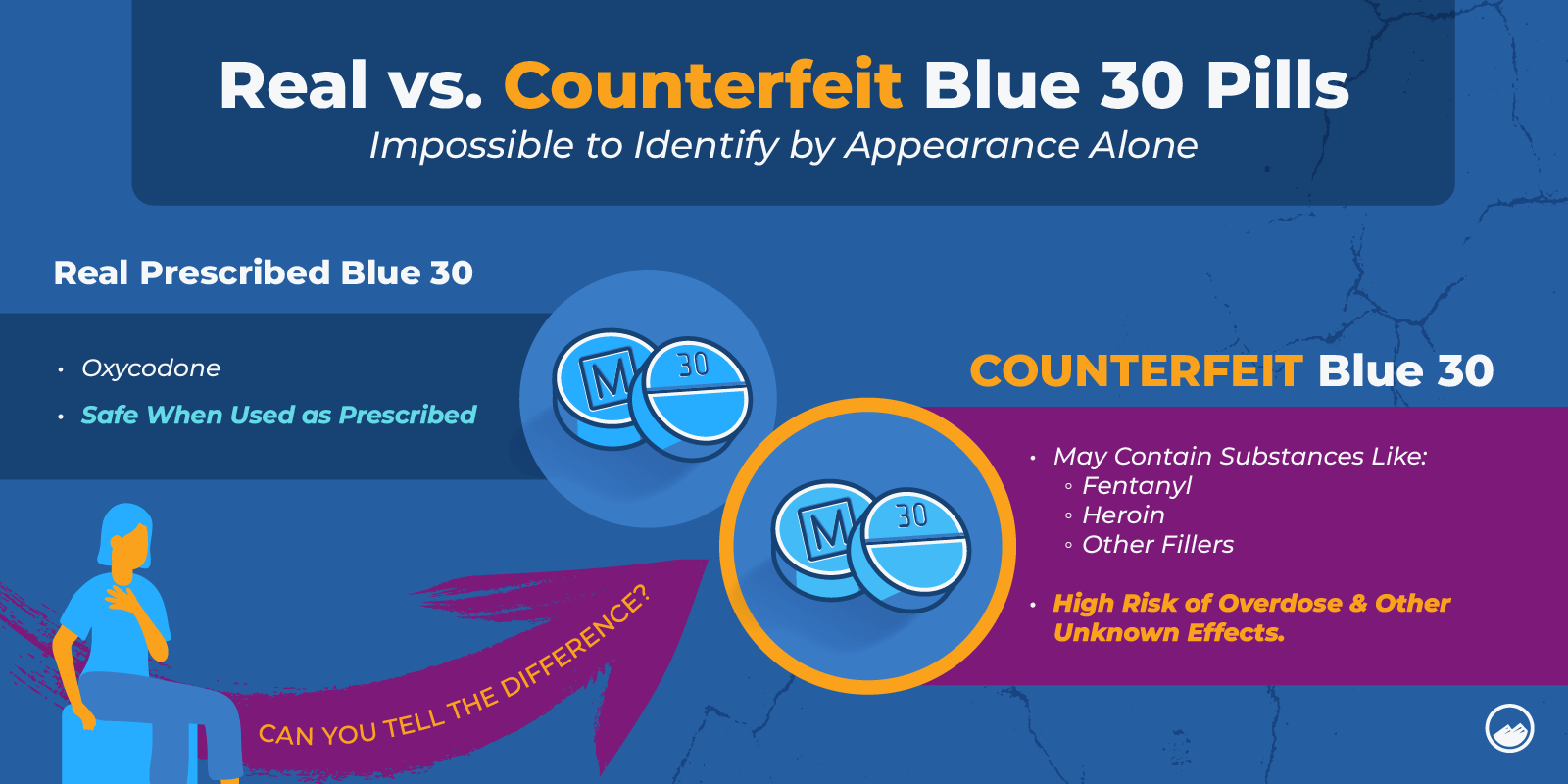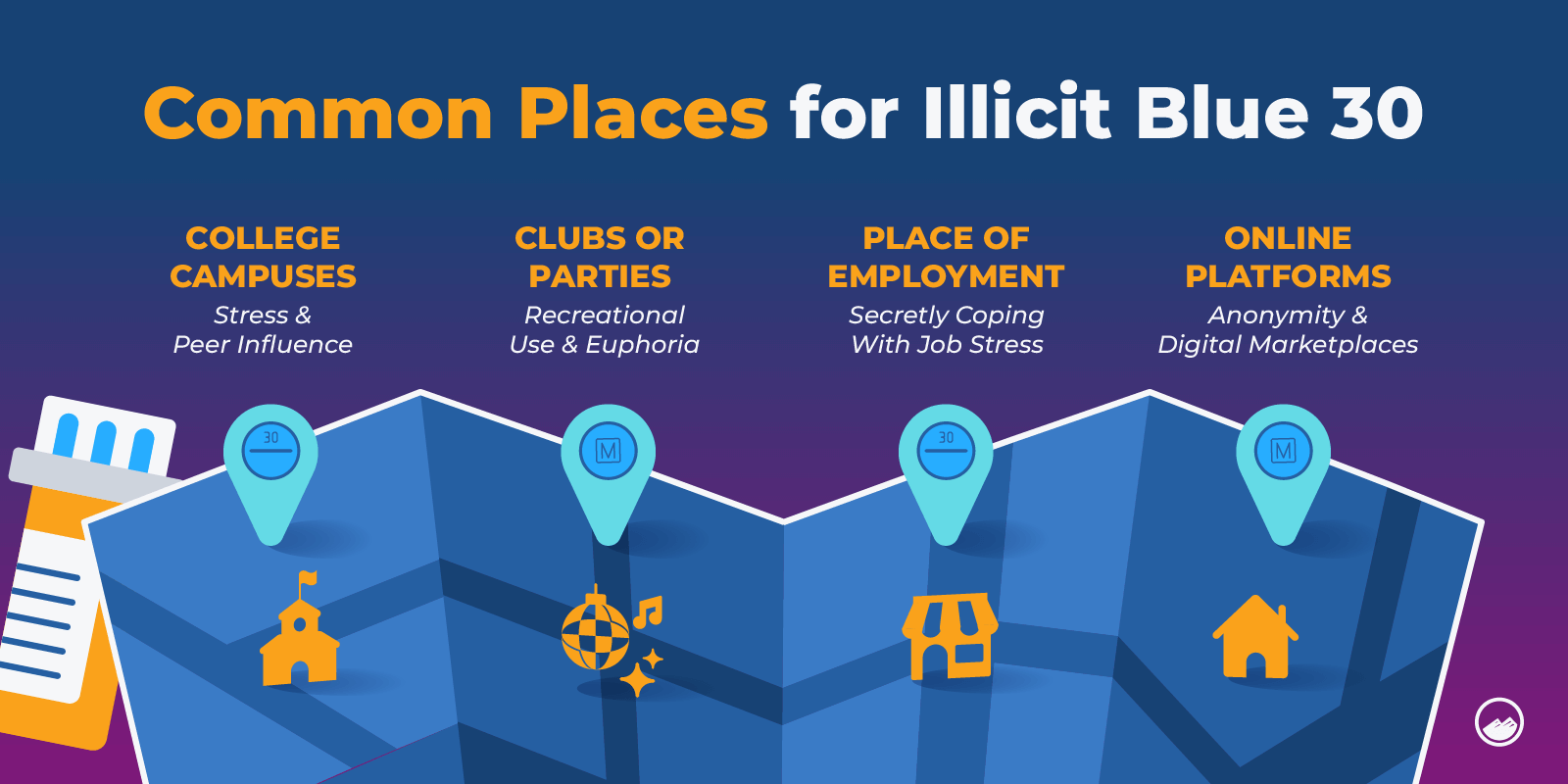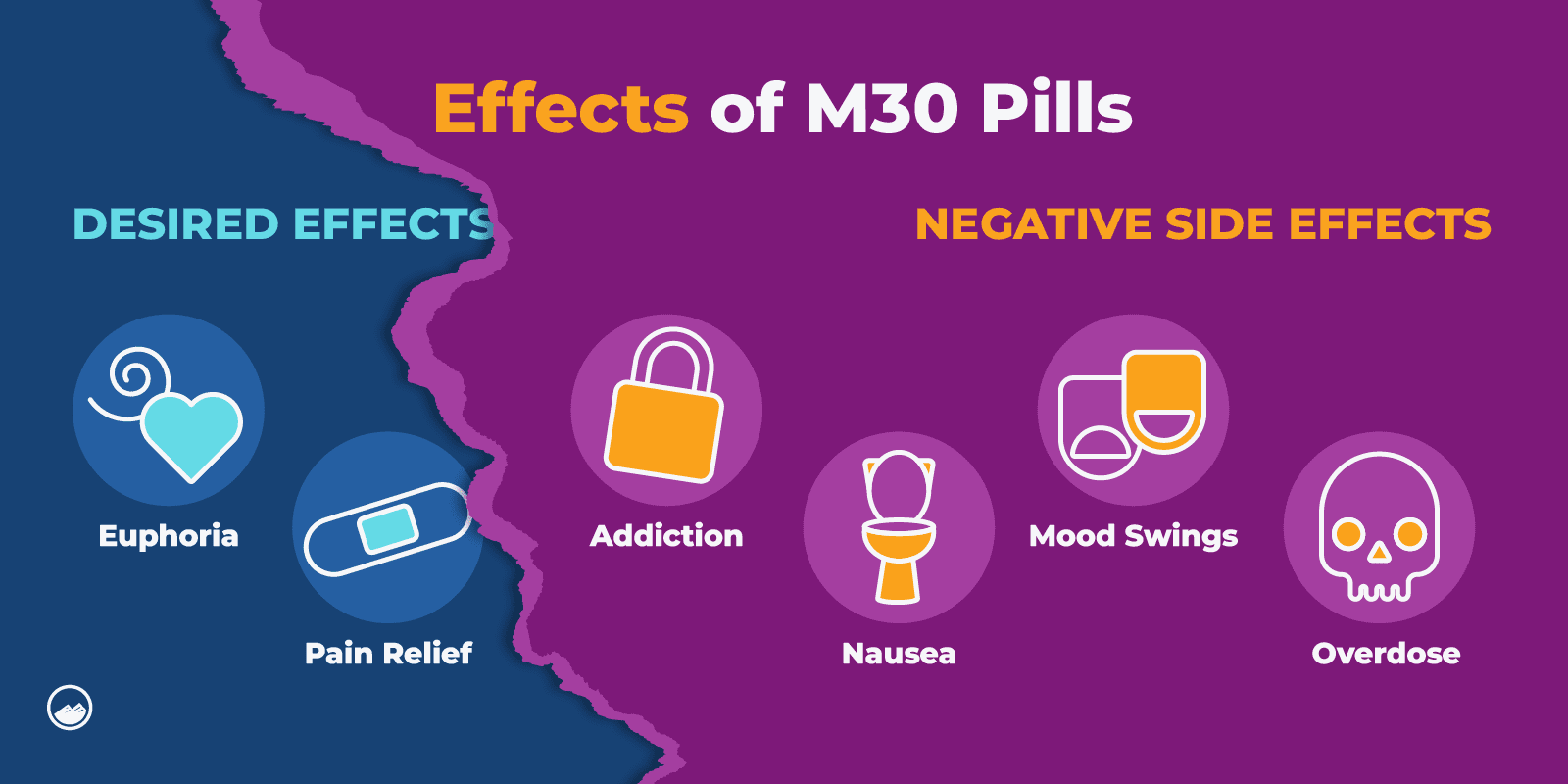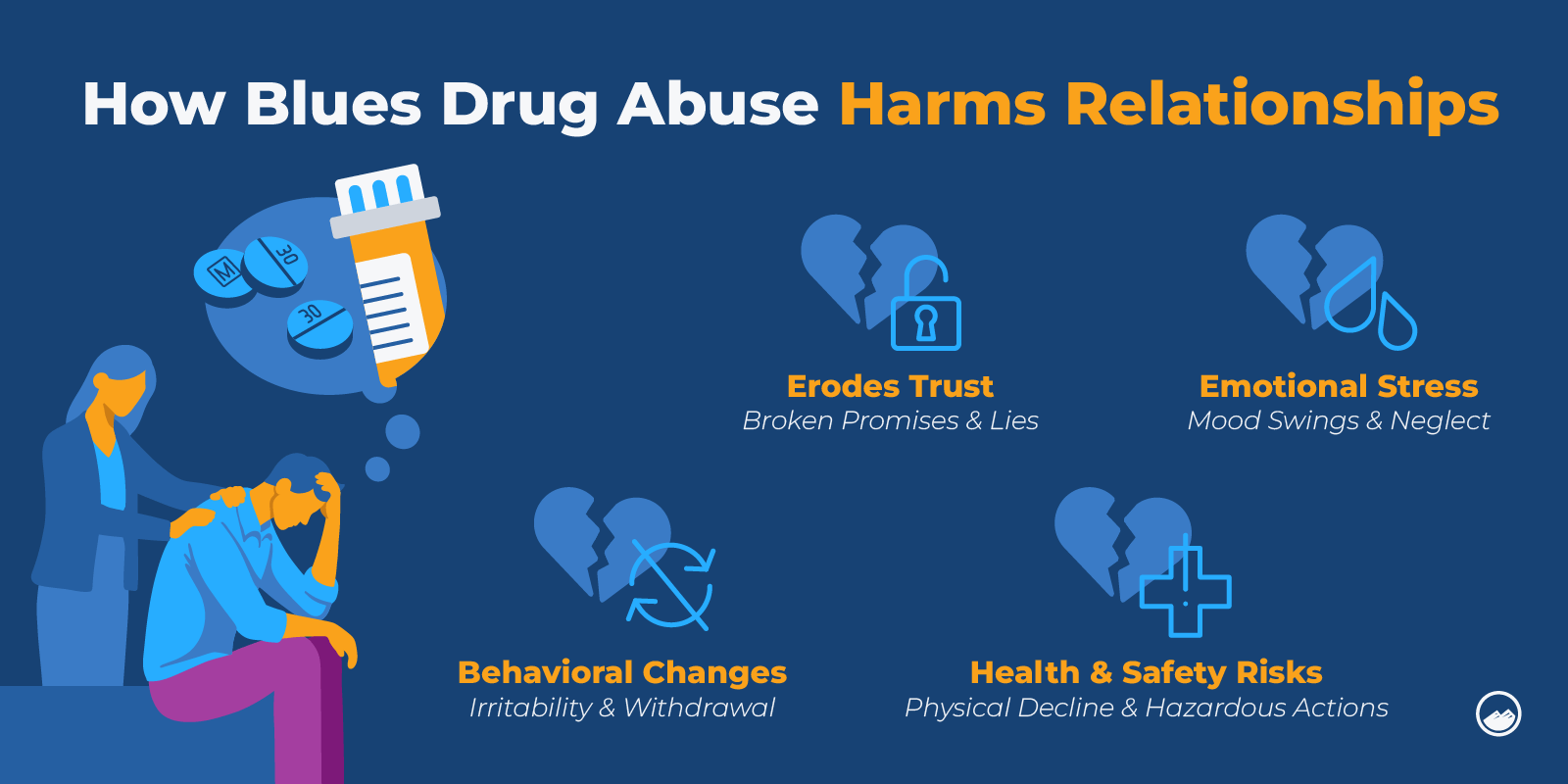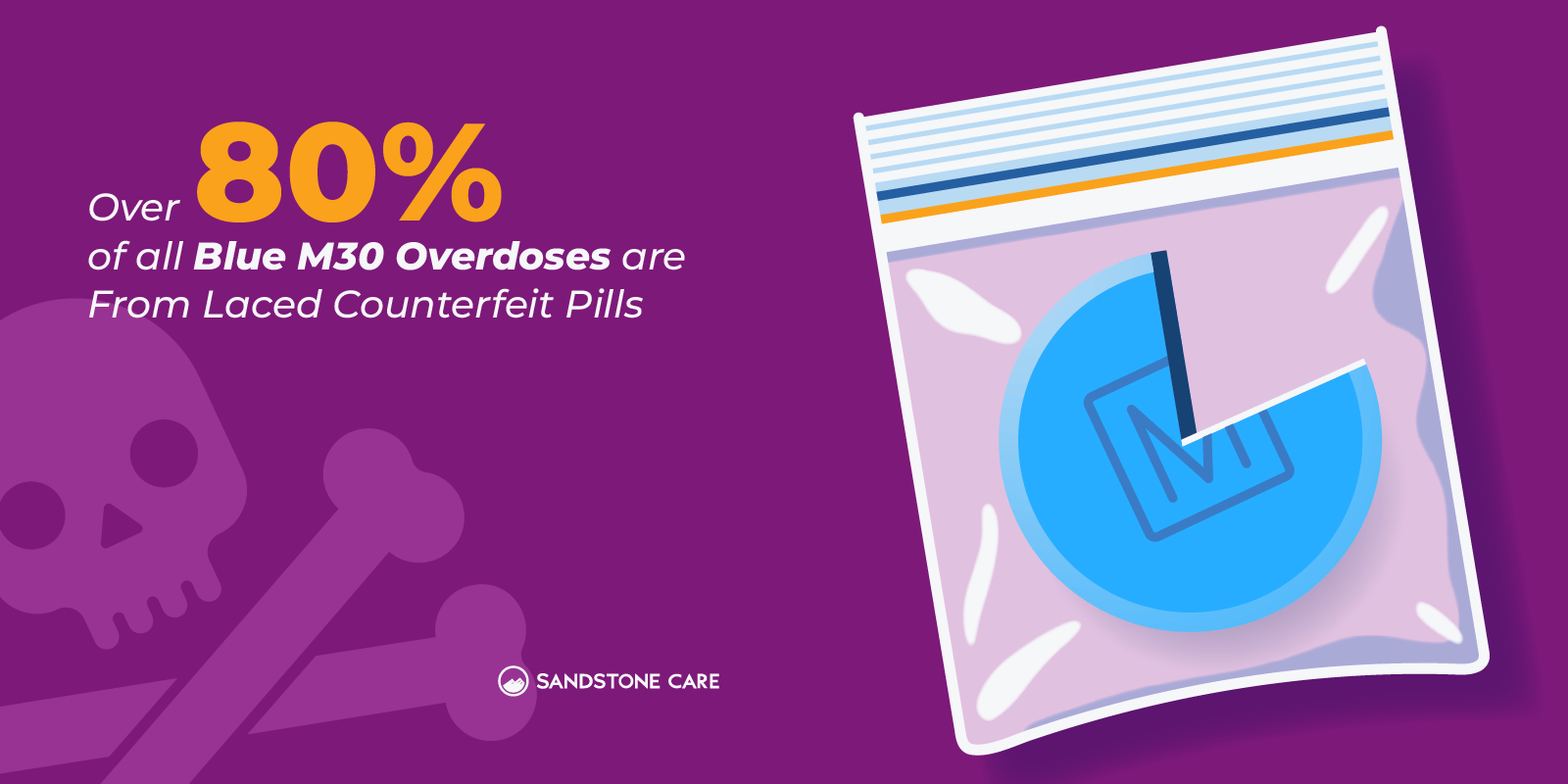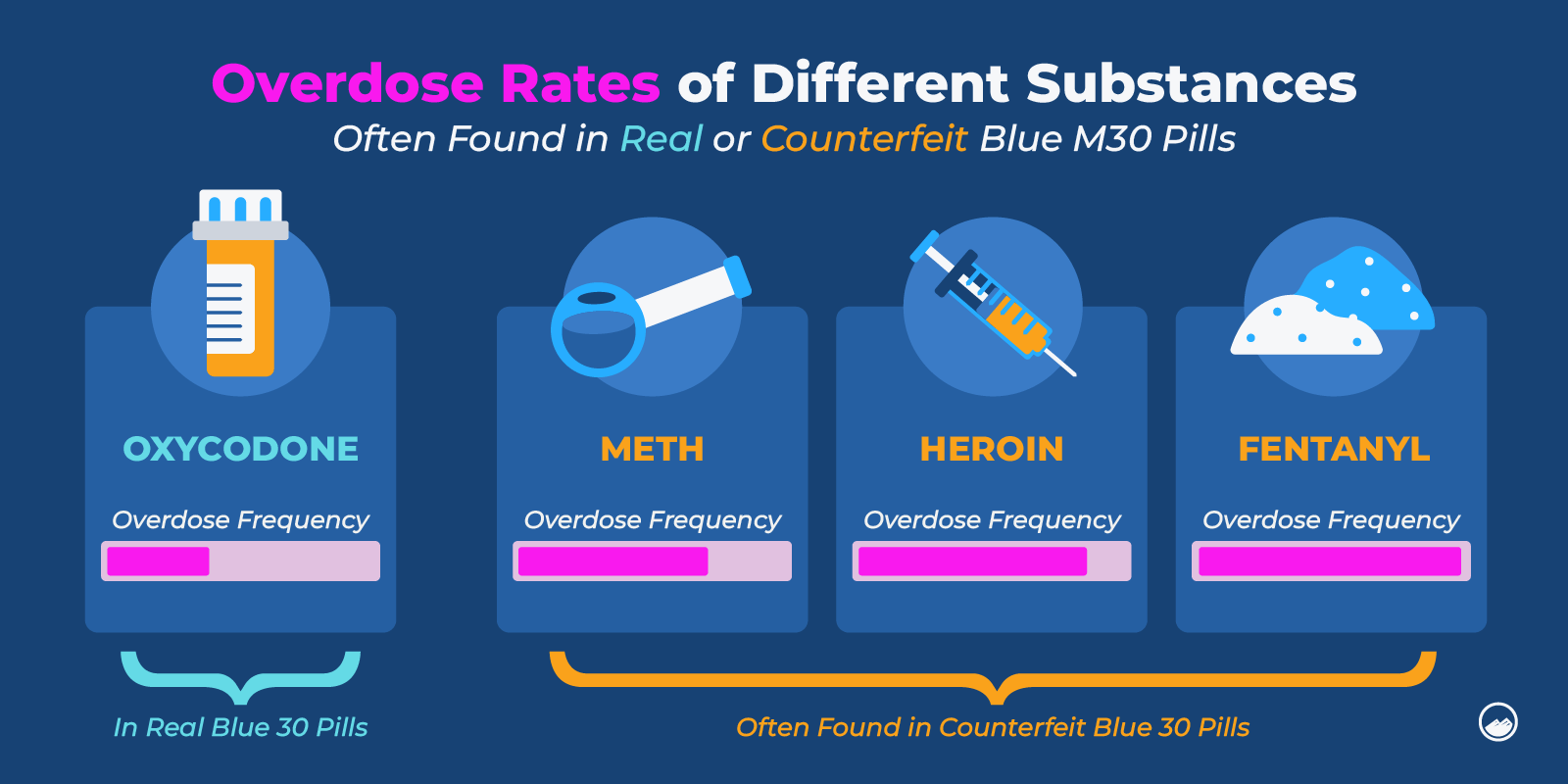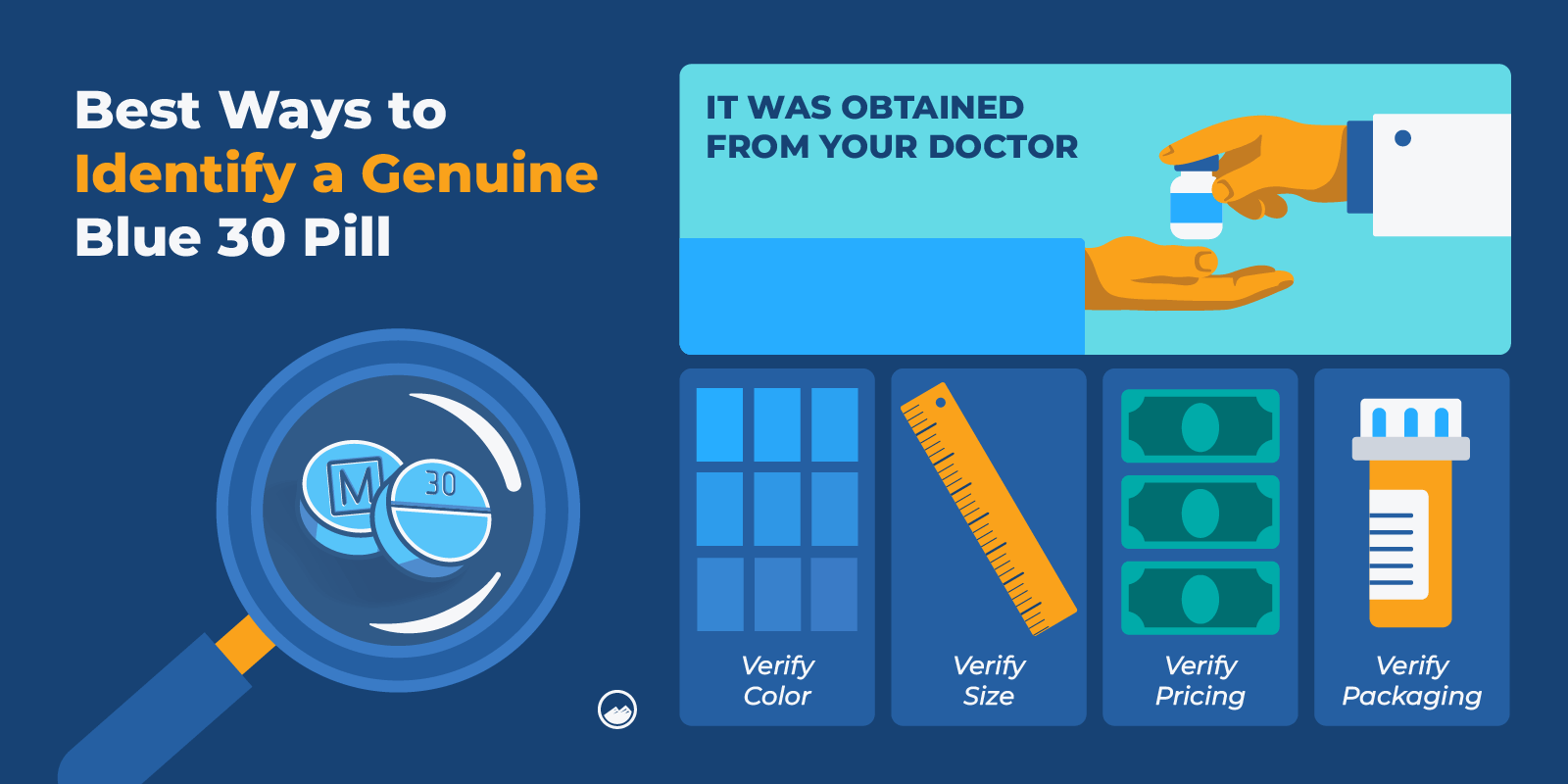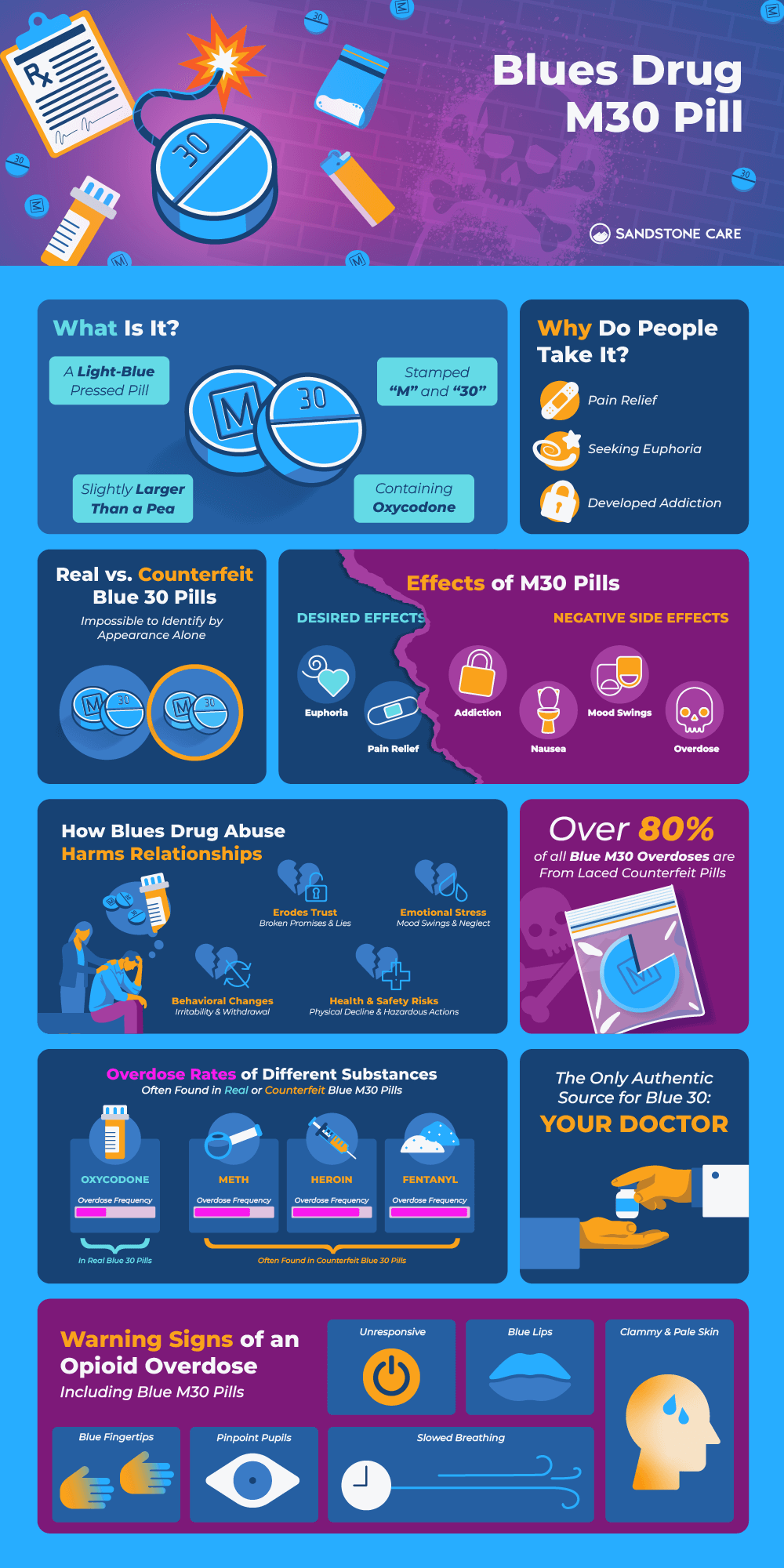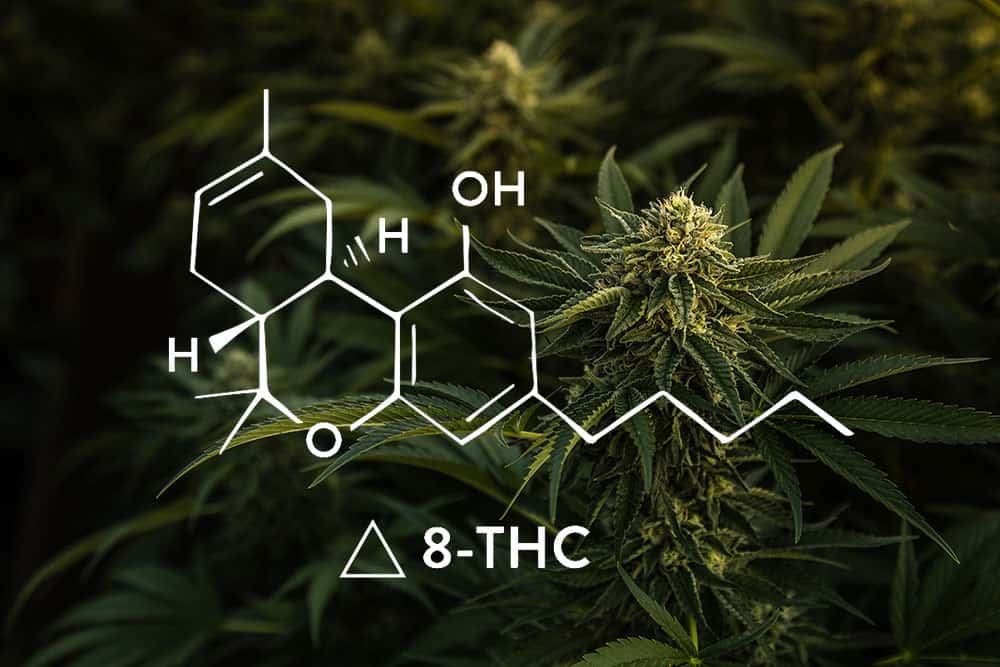The Blues Drug
What Are the Blue Pills That Say M30?
Blue pills adorned with an “M” on one side and the number “30” on the other contain the opioid oxycodone, or “oxy.”
However, while these pills can be prescription painkillers, counterfeit pills with similar colors and markings are common.
These illicit drugs may contain even more dangerous substances.
Such fake pills can be made with a wide array of other substances cut into them that can increase the risk of drug overdose.
Even when using prescription blue pills correctly, opioids like OxyContin remain highly addictive.
The use of fake pills can also introduce many dangers and lead to addiction and overdose. This is especially true among those who may not be expecting such intense drugs.
What Kind of Drug Is Blues?
Blues are a kind of opioid. Usually the term refers to oxycodone.
While such opioids have seen medical applications, they are still incredibly dangerous and can lead to drug addiction and substance abuse.
While “blues” is often used to refer to oxycodone pills, a rise in counterfeit pills that mimic the appearance of prescription drugs has led to new dangers.
What Is in M30 Pills?
Prescription M30 pills contain powerful opioid painkillers, such as oxycodone.
However, M30 pills bought on an illicit market can contain any number of other substances laced into them.
The most dangerous fake pills include synthetic opioids being pressed with fentanyl, which can lead to dangerous risks and overdose.
Are Blues Drugs Painkillers?
Blues drugs are often painkillers, since they are commonly opioids or drugs with opioid-like effects.
However, when used outside of a directed medical setting, these painkillers can come with a wide array of negative side effects.
What Are Blues Drugs in Slang?
Blues drugs can go by many slang names. M30s, blues, dirty 30s, hillbilly heroin, and mexies are some common slang names that all refer to the same drug.
What Group Uses Blues Drugs?
There is no one single demographic that is more or less susceptible to the addictive effects of opioids.
Likewise, each person will have a unique story and history with drugs.
Pursuing professional treatment from a dedicated facility like Sandstone Care is crucial to exploring the effects of addiction.
However, blues drugs can be more common in various unique situations.
First, blues pills can be found more commonly across academic campuses, such as college grounds or high schools, putting young people at risk of being exposed to blues drugs.
Dealers can also access younger people through social media platforms more quickly than older groups.
However, young people are by no means the only ones at risk.
Anyone who has received prescription painkillers can be exposed to the addictive qualities of opioids. When these prescription medications run out, some may turn to illicit alternatives.
Doing so exposes an individual to more dangerous and intense versions of the drug.
Blues drugs are a part of the ongoing opioid crisis, and there is nobody immune to their effects.
Accessibility, social pressures, local law enforcement projects, personal experiences, and more can all impact each individual’s use of these blue pills.
Blues Drugs Effects and Risks
M30s and blues drugs can profoundly affect a person’s mental, physical, and even behavioral health.
Knowing the signs of drug use and the associated risks is crucial in identifying drug use.
It’s also essential to act quickly for the health of a loved one. Identifying drug use can prompt exploring effective treatment at Sandstone Care or preventing addiction or overdose in a family member.
Can You Tell If Someone Is Using Blues Drugs?
There are several signs that an individual is using blues drugs. Not only may there be behavioral changes, but also physical indications of drug abuse.
Some of these signs of drug use include:
- Sudden mood swings or emotional dysregulation
- Drastic and sudden changes in behavior
- Nausea
- Vomiting
- Dizziness
- Sudden changes in weight
- Drastic dietary changes, such as skipping meals
- Interrupted sleep schedule, or inconsistent times of sleep and quality of sleep
- Compromised personal hygiene routines
- Pinpoint pupils
- Constant itching or scratching at the skin
These can all be signs of potential drug abuse. Coupled with signs of withdrawal when drugs are not available, finding effective treatment is necessary.
There is nothing easy about overcoming drug dependence, and many opioids and blue pills are incredibly addictive.
Professional treatment like that available at Sandstone Care is paramount to navigating these challenges and getting more information on how to support a loved one.
What Are the Effects of Blues Drugs?
Blues drugs can have destructive effects on a person’s mental and physical health such as:
- Anxiety
- Depression
- Panic
- Destructive effects on a person’s physical well-being
- Stomach pains, aches, itchiness, and fatigue are also common
Likewise, those engaging with blues drugs may begin to adopt a more secretive lifestyle.
They may also compromise personal relationships, responsibilities, academic success, or professional obligations.
Additionally, a sudden disinterest in personal hobbies or goals can be a common sign that blues drugs may be affecting daily life.
Financial challenges are also common among those living with drug addiction, especially to blues drugs.
As more finances are diverted to purchasing illicit drugs, other areas of a person’s budget can be compromised.
Such areas may include money intended for necessities like groceries or rent.
However, it can be difficult to predict precisely all of how blues drugs can affect daily life.
This is because there can be different ingredients cut into medically prescribed opioids and fake pills.
Such ingredients could include:
- Fentanyl
- Methamphetamine
Are Blues Drugs Deadly?
Blues drugs can be incredibly deadly. Even when using prescription medication blue pills through a healthcare provider, they still should be monitored carefully.
These dangers are greatly worsened when involved with fake pills. Drug traffickers often create illicit pills that can mimic the look of prescription drugs.
However, they are usually cut with more dangerous and intense substances, such as fentanyl.
Not only may fentanyl be common in fake pills, but there can also be potentially lethally high doses of it.
According to the American Drug Enforcement Administration (DEA), it is estimated six out of 10 fentanyl-laced fake pills contain lethal amounts of fentanyl.
Fentanyl is an incredibly potent drug and can be life-threatening.
This is especially true if an individual is taking the drug without being aware of how potent the pill may be.
A person taking fentanyl pills without preparing for it can quickly lead to overdose and life-threatening situations.
In 2021 alone, there were a recorded 70,601 overdose deaths related to synthetic opioids, primarily fentanyl.
However, this already staggering number does not reflect the true scope of the destructive effects of the opioid crisis.
Can You Overdose on M30?
Yes, it is possible to overdose on M30.
Not only is opioid overdose possible on M30s, but an individual may be at a higher risk of overdose than they may realize.
Even prescription medication painkillers can be highly addictive and demand careful supervision and administration to use.
Using prescription painkillers outside of the method and amount prescribed can be incredibly dangerous.
This becomes even more complicated when fake pills are involved.
Because an individual may not be aware of the various substances used in their creation, as well as their appearance mimicking prescription medication, an individual may feel like the pills are less dangerous than they truly are.
Exploring professional treatment options to address substance use is necessary.
Professional treatment helps prevent overdose and also helps navigate withdrawal symptoms and other dangerous aspects of opioid addiction.
Counterfeit M30 Pills
M30s from a healthcare provider already come with risks as they contain oxycodone – an addictive opioid.
However, counterfeit pills can come with an array of additional risks. Some risks of these risks can be life-threatening or bring an increased chance of overdose.
How to Spot a Fake M30 Pill?
Spotting the difference between a real M30 pill provided by a healthcare professional and an illicit counterfeit pill can be difficult.
Many fake pills are intentionally made to masquerade as the real thing.
Comparing a questionable pill to a real one may show some potential discoloration.
Fake pill coloration can range anywhere from their notable blue color to off-white.
However, with how difficult it can be to spot fake pills, taking what is prescribed by a healthcare provider and only as directed is the best way to monitor drug use properly.
Can Oxycodone Be Mistaken For Fentanyl?
Not only can oxycodone be commonly mistaken for fentanyl, especially in street-level drugs, but many drug traffickers will intentionally sell fentanyl that claims to be oxycodone.
Fentanyl is many times stronger than even already intense opioids like morphine.
Taking any amount of fentanyl is incredibly dangerous, especially if an individual is not expecting such a potent dose.
Doing this can potentially lead to dangerous consequences like overdose.
Are M30 Pills Legal?
Only M30 pills that are directly prescribed by a healthcare provider are legal.
However, purchasing M30s without having a prescription from street-level dealers or even using prescribed M30s in a way not directed by a medical professional is still illegal.
Likewise, even if an individual is taking M30s legally, there are still restrictions regarding their use.
For example, driving while under the effect of any opioid, whether prescribed or not, can still result in a DUI.
How to Recover From Blues Drugs
Blues drugs are highly addictive. Professional treatment at a dedicated addiction recovery facility like Sandstone Care is necessary to challenge addiction: recovery is always possible.
How Do You Treat an M30 Overdose?
Acting quickly on potential signs of an overdose is crucial during this time-sensitive situation.
Further, keeping naloxone on hand can be a life-saving treatment during signs of overdose.
Some potential signs of an opioid overdose include:
- Not responding to stimuli, such as questions, tapping, or touching
- Purple or blue fingertips and lips
- Pinpoint pupils
- Clammy and pale skin
- Slowed breathing and blood pressure
Immediately contacting medical professionals and emergency services is necessary. If possible, administering naloxone can be life-saving.
Naloxone can reverse the effects of an opioid overdose and allow a person to return to proper breathing.
If an individual is concerned about a family member or loved one using opioids, keeping naloxone on hand while exploring treatment options can be a life-saving precaution.
Experiencing an overdose is intense and can be the catalyst for many to begin to change and challenge their use of drugs.
Naloxone is a temporary solution to an immediate overdose, but it is not a replacement for dedicated treatment to truly challenge and overcome addiction.
How to Help a Loved One Who Is Using Blues Drugs?
Keeping others accountable, familiarizing oneself with treatment options, and being prepared to provide understanding and support are all crucial ways to help a loved one using blues drugs.
Blues drugs are incredibly addictive. It can be difficult to connect with a loved one who may be resistant to receiving treatment. However, there are options available.
Holding individuals accountable for their actions is incredibly important.
This means being accountable not just for mistakes or friction in these relationships but also for their finances and responsibilities.
Helping a loved one balance their finances instead of covering costs is a great way to help them recognize the gravity of the situation without enabling further use.
Contacting local facilities like Sandstone Care is another option to familiarize oneself with potential treatment options and modalities that may best resonate with a loved one.
Educating oneself is also crucial.
By familiarizing oneself with the effects and symptoms of drug addiction, each person can be more understanding of the complex challenges that addiction presents.
It is important to continue to open new dialogues and understanding going forward.
What Treatment Programs Are Effective For Opioid Use?
Detox and residential treatment programs are common and often personalized with various treatment modalities to be able to help with opioid use.
However, for many, medication-assisted treatment (MAT) is a great way to start challenging opioid addiction at a dedicated detox and recovery facility.
MAT uses medications like methadone to challenge the symptoms of opioid addiction and withdrawal.
The treatment also provides additional resources while engaging in effective mental health support.
Combining MAT with other proven therapies, such as cognitive-behavioral therapy (CBT), dialectical behavioral therapy (DBT), and experiential healing and group therapy, is necessary to create a truly comprehensive approach to treatment.
